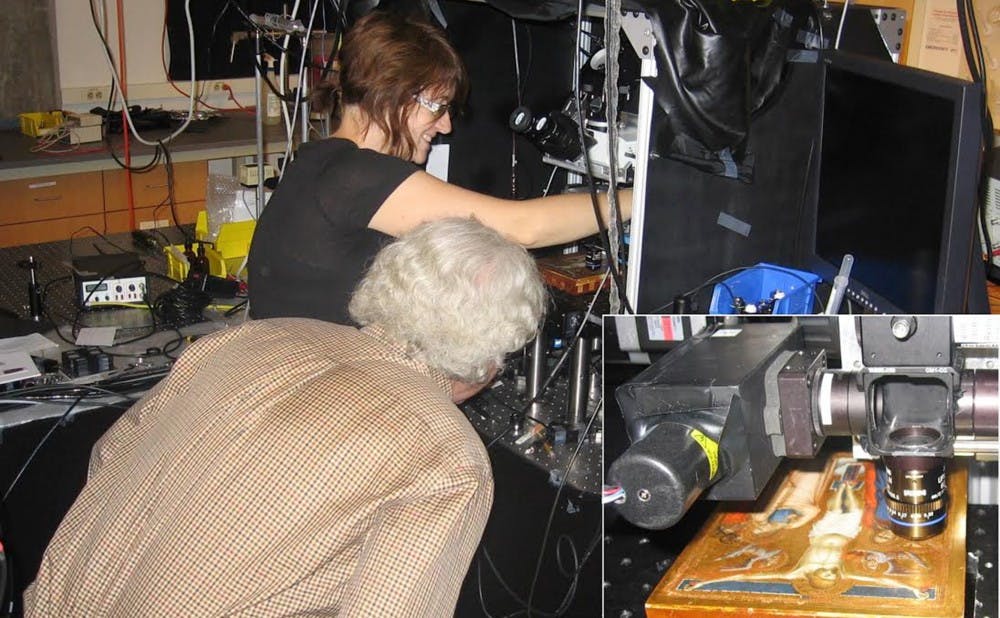"The Molecular, Physical, and Artistic Bases of Color" is being taught by three chemistry professors—Warren Warren, Martin Fischer and Adele De Cruz—who all focus on a different aspect of color. The three professors had previously worked together to utilize a laser system, originally used for biomedical imaging, to harmlessly analyze ancient works of art for their molecular compositions. Now, they are each teaching from their respective fields of expertise in an effort to impart an appreciation for the unity between arts and sciences.
De Cruz wants students of the class to see color beyond its chemical basis and how its usage has affected the course of human development.
“It forms a deeper understanding of how color influences our lives, not only on a daily basis but in the evolution of art,” De Cruz said. “Humanity always celebrated the use of color, and it’s documenting itself.”
In an email Jan. 24, Warren wrote that he will explain the concept of color at a microscopic level, Fischer will elaborate on the physical aspects of light detection, and DeCruz will describe art conservation and color from a humanistic standpoint.
“In other words, Warren will answer ‘Why?’, Fischer will answer ‘How?’, and De Cruz will answer ‘Who cares?’” Warren wrote.
The class was inspired by the multiple research groups at Duke that are studying artwork imaging across the science and engineering departments, Warren said. He added that finding people genuinely interested in both art conservation and laboratory-based work is a difficult task.
Warren said the most important lesson he wants to teach students with the class is that the great artwork in history runs deep in both physical and emotional perception, with “many aspects that are still not completely understood.”
Fischer also noted that by merging the fields of art and science, he hopes to get more people interested in the emerging interdepartmental field. He clarified, however, that he has not had any formal art background, and the class will become a continuation of learning to think outside of his traditional training.
“It’s always interesting to get into a new field and learn a language,” Fischer said. “Being able to communicate with people outside your field takes some practice and it’s a very interesting thing to do…. They have to learn our language. We have to learn their language.”
Fischer, a trained physicist who worked in the engineering department prior to the chemistry department, said the traditional boundaries between different disciplines seem to no longer apply. He hopes to encourage students to try and enjoy areas of interest that may not necessarily be in their own fields of study.
Fischer noted that there are currently few people signed up for the class after the end of drop/add and that they are unsure of how well the class will function for the students. Although there are not currently any plans to teach Bases of Color every semester, Fischer and the other professors hope to garner enough interest to continue teaching it in the future to more students interested in the frontier between the arts and the sciences.
In collaboration with the North Carolina Museum of Art, De Cruz and the other professors will be taking the students in the class to the museum to examine pigments in medieval paintings and how they change over the centuries in comparison to recreations. De Cruz said that, with the increasing intersection of arts and sciences, a greater amount of depth can be found in analyses of art.
Warren stated that scientists and artists are mutually appreciative of each other’s fields. He believes that, with the increased societal importance of biomedical research, these technologies can also function in applications for cultural heritage to offer a new and refreshing viewpoint to researchers.
“Every good scientist and physician understands that groundbreaking work usually requires the kind of broad perspective and 'thinking outside the box' that is the basic hallmark of art,” Warren said.
Get The Chronicle straight to your inbox
Signup for our weekly newsletter. Cancel at any time.

